Five Takeaways From L.E.V. Festival 2016
XLR8R travels to Spain for the tenth anniversary of L.E.V. Festival.
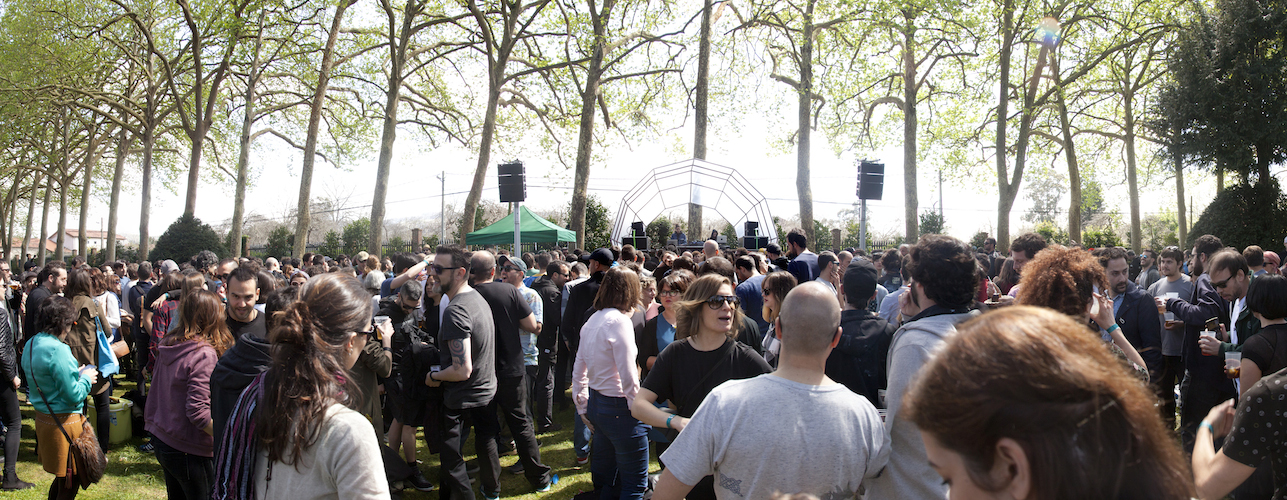
L.E.V. (Laboratorio de Electrónica Visuals/Laboratory of Visual Electronics) is something of a hidden gem of a festival, located on the northern coast of Spain. For the past 10 years L.E.V. has paved the way for contemporary avant-garde electronic arts, exploring the convergence between technology, space, and the audio and visual medias. Previous acts have included the likes of Olaf Bender, Clark, Aphex Twin, and Mika Vainio, while performances range from art installations and seated concerts, to club nights and standing gigs.
Many festivals focus purely on a safe, often one-dimensional music-listening setting—what’s special about L.E.V. is that it opens up a space in which the ideas of performance and art are tested; at the same time it attracts an open-minded crowd that are themselves willing to surpass their own existing thresholds.
The festival is located in a quaint, charming city called Gijón, in the Asturias region, with the majority of the performances taking place in the LABoral Art and Industrial Creation Centre – a majestic, almost palatial estate in East of the city, which includes a number of excellent performance spaces, including a botanical garden.
Eyes and ears open, XLR8R went over to see what the L.E.V. 10th anniversary had in store. Below are five takeaways from the weekend.
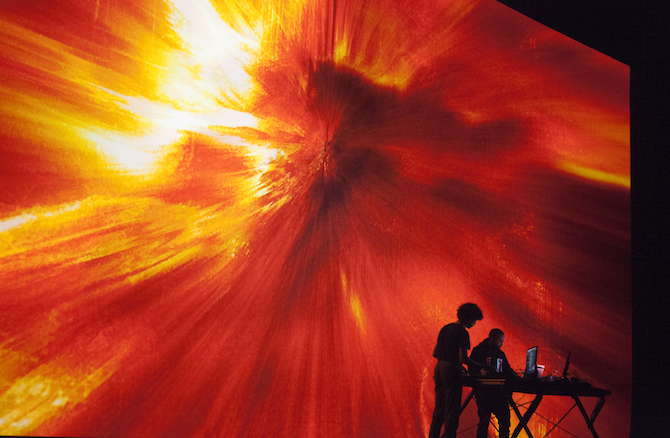
Paul Jebanasam and Tarik Barri’s “Continuum” was an intense but beautiful ride into oblivion.
“Continuum” is a collaboration between Subtext frontman Paul Jebanasam and visual composer Tarik Barri (who famously masterminded the visuals for Thom Yorke and Monolake). The performance was pretty epic, taking the audience through long arches of intense build-ups and back down into soft, timid glows that were collectively and ultimately cathartic and emotionally heart wrenching. These more tender passages were characterized by softly distorted horns and organ notes, which flickered under the subsiding ruptures.
On the screen, light flares erupted out of fiery pits of inferno, and alongside the audio it seemed as if we were travelling at light speed into the center of the sun. This passage was so intense you could almost feel the blistering heat as the sounds became totally engulfing. The visuals were all the more immersive due to the huge screen that spanned the height and width of the theatre stage. The long outro was accompanied by shimmering underwater ripples, as the remaining utterances retreated back into the dark.
It’s sadly quite rare to have such a holistically accomplished A/V show, but it made “Continuum’” all the more moving.
1,700 people sat in an auditorium watching a man make music using a television, magnetic fields, and earthquake readings, and everyone absolutely loved it.
Speaking to other festival-goers, there was already a lot of hype about Montreal-based Herman Kolgen’s upcoming performance, following a somewhat legendary appearance at L.E.V. two years ago. One of the big highlights L.E.V. 2016, Kolgen returned with a bold and demanding three-part performance.
He wished the audience luck, before embarking on an astounding audio-visual journey that was equally draining and satisfying. His set consisted of three pieces—a brand new project, KATHODd (in which he harnesses the cathode-ray tube inside a television on-stage to create spontaneous electrical currents, while using a visual sensor to create the audio), AfterShock (a conceptual piece that contemplates a post-human scenario following an apocalyptic nuclear disaster) and Seismik 2.0 (the next iteration of Seismik that was performed at L.E.V. 2014).
At many points during KATHODd, watching the sparks, flashes and static distortions on the screen and hearing the crushed up audio signals, I just thought to myself: “This is quite ridiculous, but brilliant.” The performance was quite bodily, with Kolgen moving around the TV, and pushing it across the stage. AfterShock balanced nicely in the middle, which was cinematic and displayed vast post-human landscapes that communicated the music’s stark yet highly dramatic style.
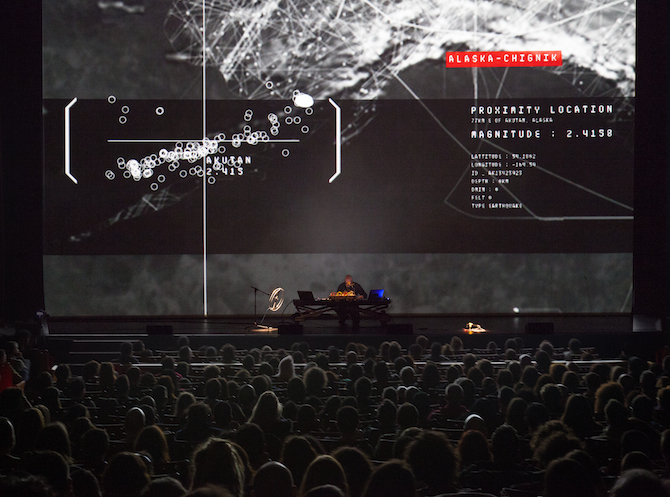
For me, conceptually and visually Seismik 2.0 was the apex of the performance. An aerial set up on stage collected (via the Internet) live data registering magnetic fields and seismic activity around the world, from São Paulo to Kyoto, generating abstract sounds and visual motifs in real-time. The data was processed by sophisticated software that Kolgen himself devised, and while watching the performance you could just about begin to understand the sheer complexity and brilliance of what he was doing. The A/V performance was erratic, jumping to different locations around the globe, shifting restlessly through noise textures, wireframe visuals, and rock formations.
The amount of work involved in refining the concepts and then developing such impressively synchronised visuals was simply mind-boggling. What’s also brilliant about Kolgen’s work is that it’s unpredictable, and is grounded in the very ungrounded possibilities of the unknown. From his short introductory talk, it was clear that these performances were in fact a collaborative inquiry between Kolgen and the audience, in which the audio and visuals become something living and organic, indulging in the as yet unseen and unexpected.
The idea that 1,700 people sat in the theatre for almost two hours to watch a man make “music” from a television and geological seismic activity is both a bizarre and wonderful thing.
A multimedia performance from Hiroaki Umeda showed us what’s possible with dance and technology.
Japanese multidisciplinary artist Hiroaki Umeda delivered a jaw-dropping performance entitled “Holistic Strata.” It was the only performance at L.E.V. that involved contemporary dance, and alongside it combined immersive spatial light projections with sonically refined noise textures. Commissioned by YCAM, “Holistic Strata” pushed the relationship between body, art and technology; Umeda’s bodily movements would be so integrated with audio and visuals so as to be seamless and unified.
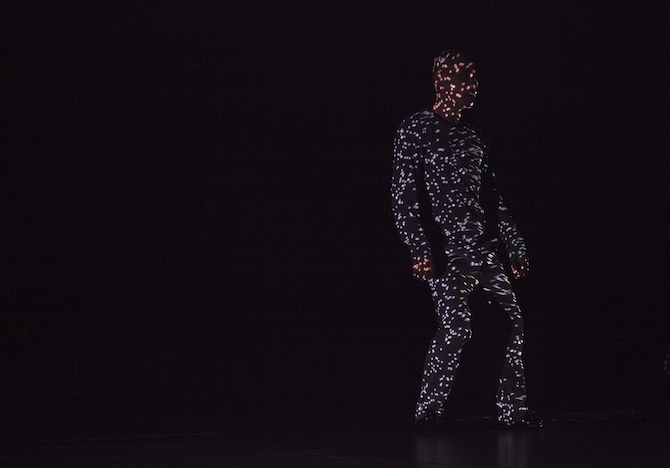
The opening scene established the elements, slowly awakening through sparse bleeps and short singular body movements. Flecks of light were projected onto his body, in which he became a smouldering collection of energy particles. There was a universal space theme and aesthetic, which was created by the black backdrop and thousands of white pixels, forming like clusters of stars and galaxies; yet the stark black and white mode and computerized music retained a clinical and mechanical touch to the whole thing, despite also being hugely effective at creating the impression of immensely vast expanses of space. Interestingly it was very reminiscent of a lot of Ryoji Ikeda’s work (another YCAM affiliated artist), which was similarly abstract and experimental and rooted heavily in glitch and musique concréte.
There was something pure and fundamental about the piece, coalescing a synergy between the highly astute choreography and A/V, with a direct and at all times purposeful expression of flow and movement (a result of his philosophy of the “kinetic force method”). At points Umeda’s body seemed to be drifting in free-fall through the black abyss, as the very fabric of space and time stretched and warped.
The level of skill, focus, and stamina required to give such a flawlessly synchronised performance was really impressive and was a tour-de-force that elicited a full standing ovation from the crowd.
High quality performances from Komatssu and Oscar Mulero showcased Asturias’ local talent and Spain’s thriving electronic music scene.
On the Sunday, Pole Group head and Asturias local Oscar Mulero presented his more experimental project: Monochrome. Departing from his usual techno framework, Mulero carried over his notoriously dark aesthetic over into more down-tempo soundscapes. There’s something distinctly noir about his music, and it translated enormously well into the Collegiate of San Juan Bautista, a redundant church that became an even more atmospheric—macabre, even—setting with the addition of ambient lighting and a smoke machine.
Mulero’s set showed his usual flair for sound programming, with abrasive textures, hard-hitting hats and weighty kicks. Desolate broken beat passages were occasionally given respite with softer, more sentimental moments, and this contrast made each section all the more evocative.
Another Asturias local, Komatssu (one half of the highly respected techno duo Exium) had two sets over the weekend: firstly his newly revised solo live show, which included a combination of old and new productions, as well as material produced specifically for L.E.V. 2016, and a DJ set going back-to-back with Mulero for the closing party.
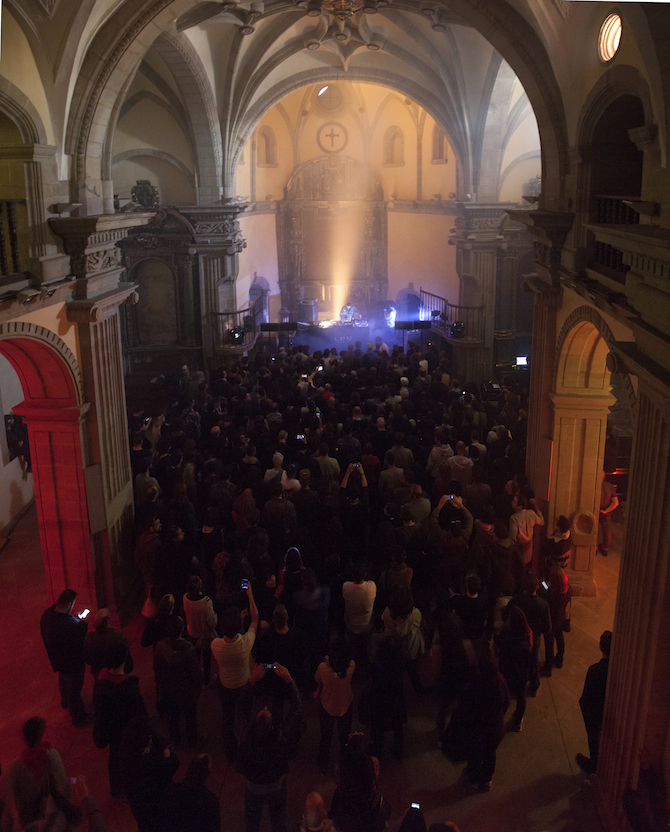
His live set provided a much-needed dose of techno during the weekend, feeding in his influences from low-slung broken beat and industrial. The crowd cheered to the heaving bass, frequent melodic passages, and at times eerie soundscapes, which all sounded rather excellent in LABoral’s Nave venue – a long studio-hall-warehouse type room in which all of the night sessions were held.
Taking place at the intimate Lanna Club, Komatssu B2B Oscar Mulero was three hours of high-octane brilliance. As a fitting tribute to the last 10 years of L.E.V., selections consisted of tracks by artists that had previously played at the festival. Komatssu opened with M83’s lush and sentimental “By The Kiss,” before sliding into Robert Lippok’s “Whitesuperstructure.” Thereafter the pair ventured into break-beat/IDM madness, with Mulero pulling off some particularly impressive mixes. Pantha Du Prince’s “Welt Am Draht” created a more introspective moment, while the harder side of things was taken care of with tracks by Andy Stott, Ben Frost and Jon Hopkins.
If you’re into electronic audio and visual arts, L.E.V. is an absolutely essential weekend for your calendar.
L.E.V. is a dream for the electronic arts enthusiast, or even just the creatively curious. The artists covered above are just a handful of highlights from a weekend that was replete with high-calibre performances–both visual and musical. The festival achieved a great balance between challenging abstract/experimental and more danceable techno and IDM, and a number of installations were made available throughout the day and night (a short departure from Nave at 3am to Robert Henke’s “Fall” installation was a real treat).
The venues are all brilliant–from the stage at the botanical garden, enclosed and surrounded by tall arching trees, miniature waterfalls, ponds, and streams, to the Theatre, which provided a much needed departure from the club setting and gave the opportunity to have a number of proper seated gigs.
To put it bluntly, the sound quality was peerless: the systems and acoustics in each of the venues were set up perfectly, which is essential for this type of highly detailed, audiophile sound-art. Sub-frequencies were eye-wateringly heavy, yet clear, while the different timbres and voices (particularly the percussion) were brought out in the sound imaging with an impressive clarity. You could also probably go as far as saying that the Funktion One set-up at the Lanna club is one of the very best in Europe (but let’s keep that a secret…).

In terms of programming, what’s interesting about L.E.V. is that the schedule is linear: all performances run consecutively so that you don’t miss anything, and everyone sees the same artists. This provided a cohesion to the weekend that’s often lost with most festivals. Many events these days have almost too much going on, with ambitious schedules sprawling out across multiple venues and incurring agonising clashes with set-times. What’s more, supplying a myriad of options in the hopes of appealing to more people can often lead to a diluted message that’s communicated through this booking process. This linear approach asserts the festival’s curatorial authority and integrity, and this is partly why L.E.V. is so successful.
As soon as I’d arrived, I noticed the crowd to be typically more mature, but also extremely warm and friendly. Although there was a mix of all ages, most were between 30—35, and everyone had an edginess and casualness about them. The vast majority were Spanish, and it was nice actually that most people didn’t really speak English. The attendance of an amiable, educated crowd created a really healthy vibe—everything flowed with ease and there was a real sense of communal experience throughout the weekend. It’s crazy how much of a difference it makes when everyone’s there purely for the performances. What’s more, the everyone was incredibly supportive and encouraging of all the artists, with full attendance from 8PM all the way through til 5/6AM.
There’s no escaping the chin-stroking stigma that’s attached to avant-garde art and music, but L.E.V. is really just an intimate meeting of like-minded people sharing a passion for art, technology, and creativity—nothing more, nothing less. I left the festival incredibly inspired by the people I met and the things I saw, and it’s weekends like these that really redefine what a great festival experience should, or could, be like. Here’s to the next ten years!






